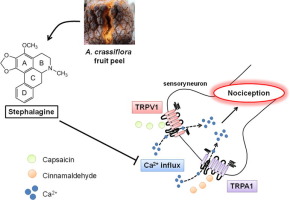当前位置:
X-MOL 学术
›
Bioorgan. Chem.
›
论文详情
Our official English website, www.x-mol.net, welcomes your
feedback! (Note: you will need to create a separate account there.)
Stephalagine, an aporphine alkaloid from Annona crassiflora fruit peel, induces antinociceptive effects by TRPA1 and TRPV1 channels modulation in mice.
Bioorganic Chemistry ( IF 4.5 ) Pub Date : 2020-01-16 , DOI: 10.1016/j.bioorg.2019.103562 Allisson Benatti Justino 1 , Marilia Fontes Barbosa 2 , Thiago Vieira Neves 1 , Heitor Cappato Guerra Silva 1 , Evelyne da Silva Brum 3 , Maria Fernanda Pessano Fialho 3 , Ana Cláudia Couto 1 , André Lopes Saraiva 1 , Veridiana de Melo Rodrigues Avila 1 , Sara Marchesan Oliveira 3 , Marcos Pivatto 2 , Foued Salmen Espindola 1 , Cassia Regina Silva 1
Bioorganic Chemistry ( IF 4.5 ) Pub Date : 2020-01-16 , DOI: 10.1016/j.bioorg.2019.103562 Allisson Benatti Justino 1 , Marilia Fontes Barbosa 2 , Thiago Vieira Neves 1 , Heitor Cappato Guerra Silva 1 , Evelyne da Silva Brum 3 , Maria Fernanda Pessano Fialho 3 , Ana Cláudia Couto 1 , André Lopes Saraiva 1 , Veridiana de Melo Rodrigues Avila 1 , Sara Marchesan Oliveira 3 , Marcos Pivatto 2 , Foued Salmen Espindola 1 , Cassia Regina Silva 1
Affiliation

|
Pain relief represents a critical unresolved medical need. Consequently, the search for new analgesic agents is intensively studied. Annona crassiflora, a native species of the Brazilian Savanna, represents a potential source for painful treatment. This study aimed to investigate the antinociceptive potential of A. crassiflora fruit peel, focusing on its major alkaloid, stephalagine, in animal models of pain evoked by the activation of transient receptor potential ankyrin 1 (TRPA1) and vanilloid 1 (TRPV1) channels. Male C57BL/6/J mice were submitted to formalin-, cinnamaldehyde-, and capsaicin-induced nociception tests to assess nociceptive behavior, and to the open-field and rotarod tests for motor performance analyses. Moreover, the stephalagine's effect was tested on capsaicin- and cinnamaldehyde-induced Ca2+ influx in spinal cord synaptosomes. In silico assessments of the absorption, distribution, metabolism and central nervous system permeability of stephalagine were carried out. The ethanol extract and alkaloidal fraction reduced the nociception induced by formalin. When administered by oral route (1 mg/kg), stephalagine reduced the spontaneous nociception and paw edema induced by TRPV1 agonist, capsaicin, and by TRPA1 agonists, cinnamaldehyde- and formalin, without altering the animals' locomotor activity. The prediction of in silico pharmacokinetic properties of stephalagine suggests its capacity to cross the blood-brain barrier. Furthermore, this alkaloid reduces the capsaicin- and cinnamaldehyde-mediated Ca2+ influx, indicating a possible modulation of TRPV1 and TRPA1 channels, respectively. Together, our results support the antinociceptive and anti-edematogenic effects of the A. crassiflora fruit peel and suggest that these effects are triggered, at least in part, by TRPV1 and TRPA1 modulation by stephalagine.
中文翻译:

Stephalagine,一种来自番荔枝番荔枝果实果皮的磷虾碱生物碱,通过调节TRPA1和TRPV1通道在小鼠中诱导抗伤害作用。
疼痛缓解代表了尚未解决的关键医疗需求。因此,对寻找新的止痛药的研究得到了深入的研究。Annona crassiflora是巴西热带稀树草原的本地物种,代表了痛苦治疗的潜在来源。这项研究的目的是研究桔梗果皮的抗伤害感受能力,重点研究其主要生物碱Stephalagine在瞬态受体电位锚蛋白1(TRPA1)和香草素1(TRPV1)通道激活引起的疼痛动物模型中的作用。将雄性C57BL / 6 / J小鼠接受福尔马林,肉桂醛和辣椒素诱导的伤害感受测试,以评估伤害感受行为,并进行开放视野和轮转测试,以进行运动表现分析。而且,stephalagine' 测试了辣椒素和肉桂醛诱导的脊髓突触小体中Ca2 +内流的作用。在计算机上对步石素的吸收,分布,代谢和中枢神经系统通透性进行了评估。乙醇提取物和生物碱成分降低了福尔马林诱导的伤害感受。当通过口服途径(1 mg / kg)给药时,stepharalagine可以减轻TRPV1激动剂,辣椒素和TRPA1激动剂肉桂醛和福尔马林引起的自发伤害性伤害和爪水肿,而不会改变动物的运动能力。对Stephalagine的计算机药物动力学特性的预测表明,其具有穿越血脑屏障的能力。此外,这种生物碱减少了辣椒素和肉桂醛介导的Ca2 +内流,表明可能调节了TRPV1和TRPA1通道,分别。总之,我们的结果支持了A. crassiflora果皮的抗伤害和抗水肿作用,并表明这些作用至少部分是由Stephalagine调节TRPV1和TRPA1触发的。
更新日期:2020-01-17
中文翻译:

Stephalagine,一种来自番荔枝番荔枝果实果皮的磷虾碱生物碱,通过调节TRPA1和TRPV1通道在小鼠中诱导抗伤害作用。
疼痛缓解代表了尚未解决的关键医疗需求。因此,对寻找新的止痛药的研究得到了深入的研究。Annona crassiflora是巴西热带稀树草原的本地物种,代表了痛苦治疗的潜在来源。这项研究的目的是研究桔梗果皮的抗伤害感受能力,重点研究其主要生物碱Stephalagine在瞬态受体电位锚蛋白1(TRPA1)和香草素1(TRPV1)通道激活引起的疼痛动物模型中的作用。将雄性C57BL / 6 / J小鼠接受福尔马林,肉桂醛和辣椒素诱导的伤害感受测试,以评估伤害感受行为,并进行开放视野和轮转测试,以进行运动表现分析。而且,stephalagine' 测试了辣椒素和肉桂醛诱导的脊髓突触小体中Ca2 +内流的作用。在计算机上对步石素的吸收,分布,代谢和中枢神经系统通透性进行了评估。乙醇提取物和生物碱成分降低了福尔马林诱导的伤害感受。当通过口服途径(1 mg / kg)给药时,stepharalagine可以减轻TRPV1激动剂,辣椒素和TRPA1激动剂肉桂醛和福尔马林引起的自发伤害性伤害和爪水肿,而不会改变动物的运动能力。对Stephalagine的计算机药物动力学特性的预测表明,其具有穿越血脑屏障的能力。此外,这种生物碱减少了辣椒素和肉桂醛介导的Ca2 +内流,表明可能调节了TRPV1和TRPA1通道,分别。总之,我们的结果支持了A. crassiflora果皮的抗伤害和抗水肿作用,并表明这些作用至少部分是由Stephalagine调节TRPV1和TRPA1触发的。











































 京公网安备 11010802027423号
京公网安备 11010802027423号